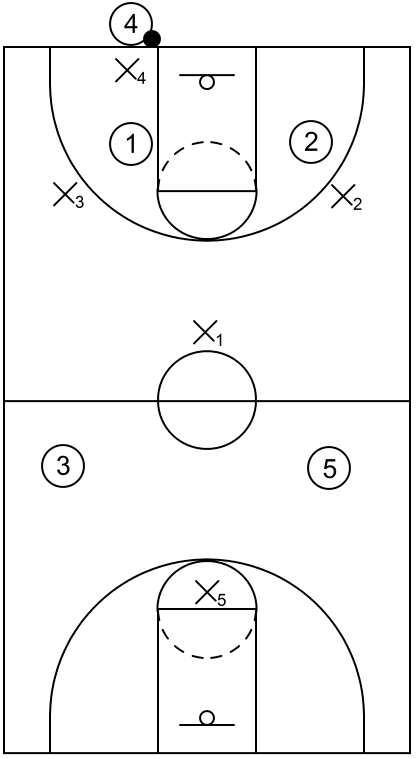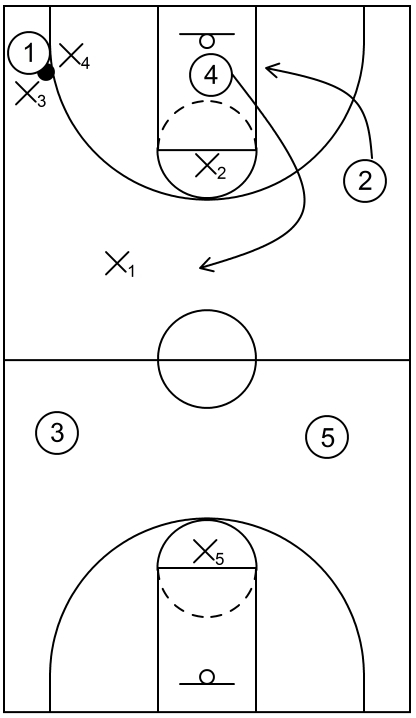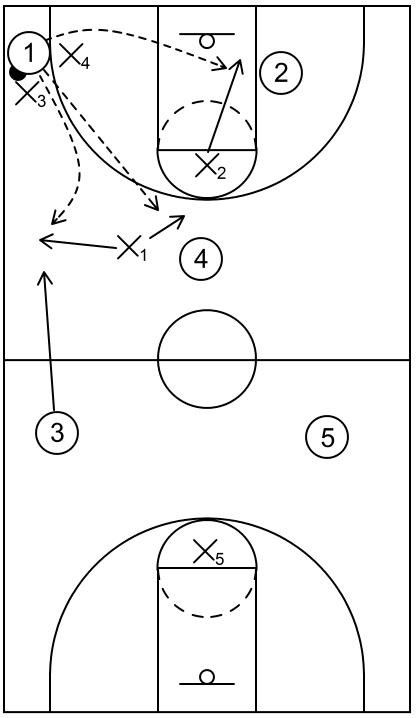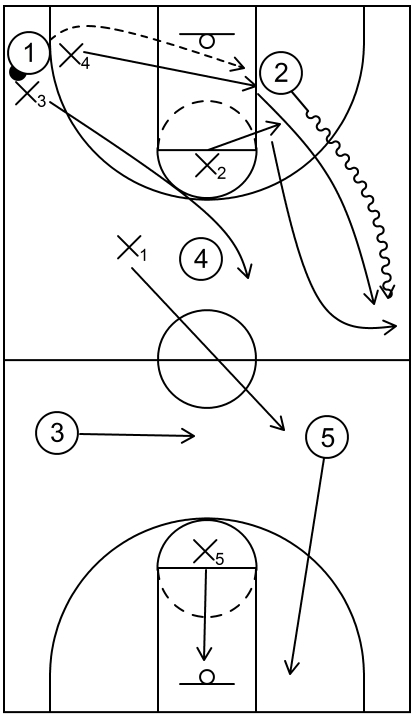What is the havoc press defense in basketball
The havoc press defense is a basketball defensive strategy which utilizes on-ball pressure and defensive traps, particularly in the backcourt, with a main objective of influencing the offensive team to play at a faster pace than usual, which could then lead to turnovers by that same offensive team.
Additionally, the havoc press defense is a variation of the 1-2-1-1 full court press defense and it was initially developed and popularized by Coach Shaka Smart during his time as the head coach of the VCU Rams men’s basketball team.
What is an example of the initial formation for the havoc press defense

This is an example of the initial formation for the havoc press defense. X4 starts near the baseline and executes immediate defensive pressure against the player that should inbound the ball.
X3 and X2 start near the wing areas in the backcourt while X1 also starts in the backcourt near the half court line below the center circle. Lastly, X5 starts near the high post area on the opposite side of the floor in the frontcourt.
What are the general responsibilities of the defenders within the havoc press defense
The responsibilities of X4 are to execute immediate pressure on the player with the ball that will inbound it.
Following that, once another offensive player receives the ball via the inbound pass, X4 should try to influence that same player towards the corner, preferably near the baseline.
From that point, X4 could set a corner trap with X2 or X3, whichever one of those defenders is on the same side as the ball.
The responsibilities of X2 and X3 on the same side of the ball are to set a corner trap alongside X4.
Additionally, if X2 or X3 is not setting a trap, then X2 or X3 should cover the middle area while also being prepared to intercept passes towards the middle or the opposite side of the court.
The responsibilities of X1 are to stand in the gap between the middle of the court and the ball side wing area. From this point, X1 could either intercept any passes towards the middle or towards the ball side wing area.
The responsibilities of X5 in the frontcourt are to guard the high post area or drop down to protect the basket if necessary.
What are general differences between the havoc press and the 1-2-1-1 press
One notable difference between the havoc press and the 1-2-1-1 press is that in the havoc press, there is immediate pressure on the offensive player that will inbound the ball by the defender at the top of the press.
Another key difference between the havoc press and the 1-2-1-1 is that the havoc press heavily emphasizes forcing the offensive player that has possession of the ball into the backcourt baseline corners.
Afterwards, two defenders will execute a corner trap against the player with the ball, which could then lead to a bad pass and subsequent turnover.
However, the 1-2-1-1 press focuses more on simply influencing the player with the ball near the sideline in general, followed by trap defense thereafter.
Furthermore, in the havoc press, generally speaking, when the offensive team is able to bypass the initial corner traps in the backcourt and then successfully move the ball into the frontcourt, the defensive team will usually switch into a half court defensive strategy such as man to man or zone defense.
What is an advantage of the havoc press defense
One particular advantage of the havoc press defense is that it could be useful for teams that have speed, quickness, great conditioning, but only average or less than average individual offensive skill sets.
Essentially, if a team is not very good at perimeter shooting, particularly from three-point range, and/or a team is average or below average at generating scoring opportunities, primarily by way of dribble penetration to attack the rim, then that team could implement the havoc press to gain extra offensive possessions via defensive interceptions or other types of possible turnovers such as an inaccurate pass by an offensive player that goes out of bounds.
In other words, the team that executes the havoc press could use their defensive skills to compensate for their average or less than average offensive talents. For example, if the defensive team is able to generate live-ball turnovers, primarily via interceptions, especially in the backcourt, then this could lead to points such as layups by way of transition offense.
What is a disadvantage of the havoc press defense
One notable disadvantage of the havoc press defense is that if the offensive team knows how to counter the backcourt defensive pressure, either by staying away from the corners or the offensive team is able to pass the ball into the gaps of the press, especially in the middle (which basically breaks the press), then the havoc press might not be as useful as another type of full court press or other defensive strategies.
Furthermore, in the havoc press defense, there is only one defender in the back to protect the basket. Therefore, if the offensive team is able to push through the initial backcourt pressure, then they will most likely have a numbers advantage in the frontcourt.
This could then give the offensive team the opportunity to score near the basket via layups or from the perimeter by way of open jump shots, particularly from three-point range.
The reason that a potential scenario such as this could occur is because the frontcourt defender would not be able to guard against two or more offensive players.
At least one of those offensive players would most certainly be open, even if it is only temporarily while the backcourt defenders sprint into the frontcourt area to match up with man to man defense or cover specific areas with zone defense.
So, the havoc press defense could be considered as a high risk, high reward defensive strategy. In other words, defensive teams that decide to implement this particular press have an opportunity to create scoring opportunities, particularly in the backcourt, by way of turnovers, especially live-ball turnovers.
Yet, those same defensive teams could potentially get scored on multiple times if the offensive team possesses the basketball IQ to break the havoc press.
What are examples of the havoc press defense
Example 1

This is an example of the havoc press after a player receives the ball via the inbound pass. For this case, 1 receives the ball near the baseline corner and this triggers an immediate corner trap by X4 and X3.
As that occurs, 4 cuts to the middle area of the press while 2 cuts back toward the lane as a safety option to release the pressure from 1. This also creates a 2-1-2 offensive alignment as a counter to the press as well.
Following that, X1 stands near the gap between 4 and 3 waiting in anticipation for a possible interception while X5 simply stays near the high post in the frontcourt for the time being.
Example 2

This is an example of the havoc press with potential interception options for the defensive team. To begin, if 1 attempts to pass towards the middle with 4 as the recipient, then X1 could step into the passing lane to intercept the ball.
If 2 is the recipient of the pass from 1, then X2 could possibly intercept that pass. Additionally, if 3 steps into the backcourt as another viable option, then X1 could intercept that pass as well.
Example 3

This is an example of the havoc press if an offensive player executes a skip pass to the opposite side of the court. For this case, 2 is able to receive the ball from 1.
When that occurs, X2 should try to contain the ball and stay in front of 2 while X4 sprints hard across the court to influence 2 away from the middle and towards the sideline.
After that, if 2 dribbles toward the frontcourt near the sideline, then X2 and X4 could set a trap near the half court line before 2 crosses into the frontcourt.
Additionally, as that action happens, X3 sprints across to cover the middle in the backcourt while X1 cuts into the frontcourt to stand in the gap between the middle and the ball side wing area.
The purpose of that action is to primarily take away an easy pass to the middle in the frontcourt as can be witnessed by 3 cutting towards the middle.
Also, if 5 sprints down to the low post block, then X5 can drop down to protect the basket.
What are comparable defensive strategies in relation to the havoc press
The 1-1-2-1 press defense is a full court press that makes use of sideline traps to potentially create turnovers. This particular press utilizes pressure in the backcourt and afterwards, defensive players set the sideline traps in the frontcourt, typically near the half court area.
The 1-2-1-1 press defense, also known as the diamond press, is a basketball defensive strategy that features full court pressure and sideline traps, particularly in the backcourt which could lead to limited scoring opportunities as well as possible turnovers for the offensive team.
The 1-1-3 press defense is a full court press that makes use of sideline traps to potentially create turnovers. This particular press starts off very aggressive as the three defenders in the back of the press are pushed up towards the half court line with little to no initial rim protection.
The 1-3-1 press defense is a type of basketball defensive strategy that implements traps near the sidelines, which in turn, could limit offensive scoring opportunities. A unique attribute of this press is that it begins with only one defender in the backcourt while the other defenders typically remain in the backcourt.
The 1-2-2 press defense features sideline traps, particularly in the backcourt as well as the frontcourt, which could then limit scoring opportunities or create potential turnovers. It could also be considered a low risk, high reward type of press as the primary focus is typically on ball containment and the disruption of the offensive flow unlike other more aggressive types of press defenses.
The 2-2-1 press is another full court press defense that features frontcourt and backcourt sideline traps. This particular press could be good against teams that have average or less than average basketball IQ.